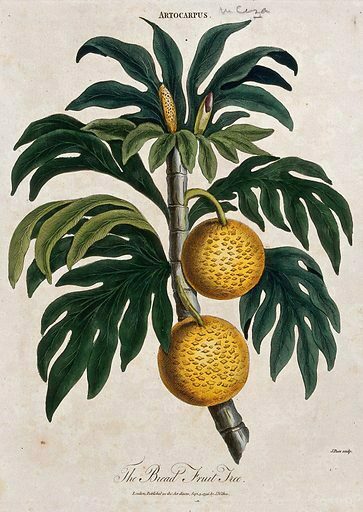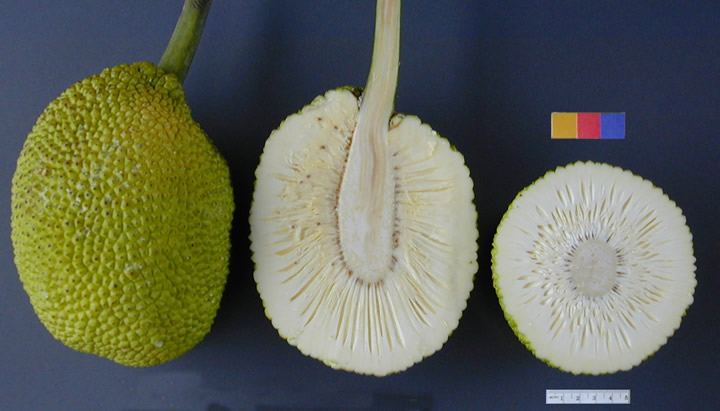

It is a species belonging to the Moraceae family, whose fruit – brother cousin of the Jackfruit – has a bread-like flavor and great nutritional value; it also has agro-industrial potential for human and animal food.
Origin and geographic distribution
The Breadfruit Tree is native to the islands of Java and Sumatra, islands of the South Pacific, being introduced to America (Caribbean islands) by the English in 1793. It is cultivated in the islands of the Asian archipelago and tropical regions of the world, including the Amazon rainforest in South America (IIAP, n.d.) (1).
Other common names
Breadfruit, Tree bread, Breadfruit (Ecuador); Fruta paó or Breadfruit (Brazil); Guampano (Colombia); Pan de Pobre and Pandisho (Peruvian and Brazilian Amazon); Marzipan (Guatemala); Pana, Pabum (Cacataibo); Paum (Cashibo); Haitian, Pan de pobre, Paon (Shipibo-conibo); Laquero, Ciri-bredebon (Suriname) (IIAP, n.f.; Bendaña, 2017) (1) (2).

Botanical description of the Breadfruit Tree and its fruit
It is a tropical monoecious tree with a straight trunk that has lactíferos with a viscous latex; it can reach between 10-25 meters in height when growing as natural vegetation and 8-10 meters when cultivated. Its crown is leafy with broad, oval to elliptical leaves. It is estimated that each tree can produce approximately 150-200 kg of fruit each year (Bendaña, 2017) (2).
The fruit of the species Artocarpus altilis is composed of the union of many ovaries; it is generally round, oval or oblong and measures more than 30 cm long and between 9 and 20 cm wide, and can weigh between 250 grams and 6 kg. It has a soft and fleshy texture and its color varies between light green, yellowish green and yellow. Good quality fruits are dark green, firm, with intact stalk, and free of defects. This fruit stands out for its high quality protein content (higher than banana or yam, and easier to digest than wheat), in addition to being rich in carbohydrates and a good source of vitamins and minerals (Cabrera and Castillo, 2017) (3).
Breadfruit tree has two cultivars: in one, the fruit has seeds, while in the other it lacks seeds and only consists of a soft, whitish mass (Cabrera and Castillo, 2017) (3). The fruit can be eaten when ripe, or it can be dried and ground into flour, which offers a gluten-free protein option.

Nutritional value
Tree Bread can be considered a superfood. According to IIAP (n.d.) (1), the content of 100 grams of edible part provides: protein 4.5 g, carbohydrates 29 g, fiber 3.1 g, calcium 20 mg, phosphorus 255 mg, iron 0.9 mg, thiamine 0.22 mg, riboflavin 0.09 mg, niacin 2.6 mg, ascorbic acid 0.6 mg.
According to Monreal (2018) (5), considering expert opinion, Breadfruit contains more amino acids than soybeans. In addition, according to researchers at the National Tropical Botanical Garden of Hawaii, this fruit is a healthy substitute for bread or any other starchy food such as rice or potato, if boiled or steamed, or baked. It provides almost half of the recommended daily value of dietary fiber as well as minerals and vitamins that contribute to a healthy diet.
Food uses and potentials
The use of the fruit of the Breadfruit Tree in human nutrition is very diverse; it can be added to soup, mashed, used as a garnish for a dish – replacing potatoes, cassava, yams or plantains – boiled, fried or baked. It is also added in the preparation of sweets and cakes. Likewise, the seeds are edible and can be consumed fried, roasted or cooked; likewise, they can be added to different dishes (Bendaña, 2017) (2).
On the other hand, by planting the Breadfruit Tree for commercial purposes, it is possible to add value to the fruit in the agro-industry, in order to obtain flakes of the type snacks fried and packaged; flours that can be used in the food industry as precooked flours, instant soups, baking and biscuits, whole-grain products, among others (Bendaña, 2017) (2).
On the other hand, the fruit of Artocarpus altilis has been used in the feeding of domestic animals, mainly pigs and poultry. From breadfruit meal, pellets can be made that can be used in poultry, swine and ruminant feed, alone or combined with other ingredients, or incorporated into balanced rations for animal feed (Bendaña, 2017) (2).
Non-food Uses of Breadfruit
The wood of Artocarpus altilis is highly productive and is traditionally used for the construction of houses and canoes, handicrafts and others. The latex secreted by the tree, subjected to medium temperatures, is a good glue. Additionally, the leaves, roots, and latex are used for medicinal purposes (Bendaña, 2017) (2).
Health benefits
Breadfruit is high in vitamin C, which is important for iron absorption and is also a powerful antioxidant. Likewise, its contribution of vitamins A and B, as well as minerals such as potassium, calcium, magnesium, phosphorus and iron, strengthen bones and teeth, improve muscle tone, as well as being beneficial for skin and hair. Also, this super fruit prevents cardiovascular diseases, given its content of phytochemicals (Monreal, 2018) (5).
From the perspective of traditional natural medicine, Pandisho is used in the treatment of various diseases or ailments; it is antiasthmatic, antidiarrheal, antihypertensive, hypoglycemic, deworming or anthelmintic, relieves conjunctivitis, among other beneficial health effects. In the case of diabetes, asthma and hypertension, it is recommended to take the infusion of the leaves of the fruit, while the flesh of the fruit is used in infusion as an antidiarrheal. The application of the latex extracted from the tree, is used in the form of plasters to heal burns, relieve insect bites, eliminate warts, as well as in the treatment of rheumatism (CIBIOMA, 2017) (4).
References
- Peruvian Amazon Research Institute, IIAP. (S.f.). Pandisho. Retrieved from http://www.iiap.org.pe/upload/publicacion/CDinvestigacion/iiap/iiap2/CapituloIII-32.htm.
- Bendaña García, G. (2017). Agrifood and agroindustrial potential of the humid tropics of Nicaragua (second part). Temas Nicaragüenses, (108), 297-350. Retrieved from https://d1wqtxts1xzle7.cloudfront.net/65407649/RTN_108_abril_2017-with-cover-page-v2.pdf?Expires=1655486972&Signature=N9TF1MSIfj2syTO3ixbPv
- Cabrera Durán, E. and Castillo Martínez, J. (2017). Exploitation of breadfruit (Artocarpus Altilis) to obtain a food derivative (flour). Research and Innovation in Engineering Journal, 6(2), 1-17. Retrieved from http://revistas.unisimon.edu.co/index.php/innovacioning/article/view/3110/3827.
- Biodiversity and Environment Research Center, CIBIOMA. (2017). Breadfruit or breadfruit. Retrieved from https://www.cibioma.edu.bo/0318planta.htm.
- Monreal, A. (24/10/2018). Breadfruit: properties, benefits and nutritional value. La Vanguardia, retrieved from https://www.lavanguardia.com/comer/frutas/20181024/452518591456/fruta-del-pan-frutas-propiedades-beneficios-valor-nutricional.html#:~:text=La%20frut.

Economist (Central University of Venezuela). Full professor and researcher attached to the “Edgar Abreu Olivo” Agrifood Research Center, Universidad de Los Andes. Doctor from the University of La Laguna (Spain). Award “One of the 10 most consulted authors of the Saber ULA university portal” (2005); prize in the III Essay Contest of the Central Bank of Venezuela BCvoz Economico, 2016, with the work “Theobroma cacao: transformation and consumption of the “food of the gods” in Venezuela and the world” (co-authored).
This post is also available in:
![]() Español (Spanish)
Español (Spanish)
